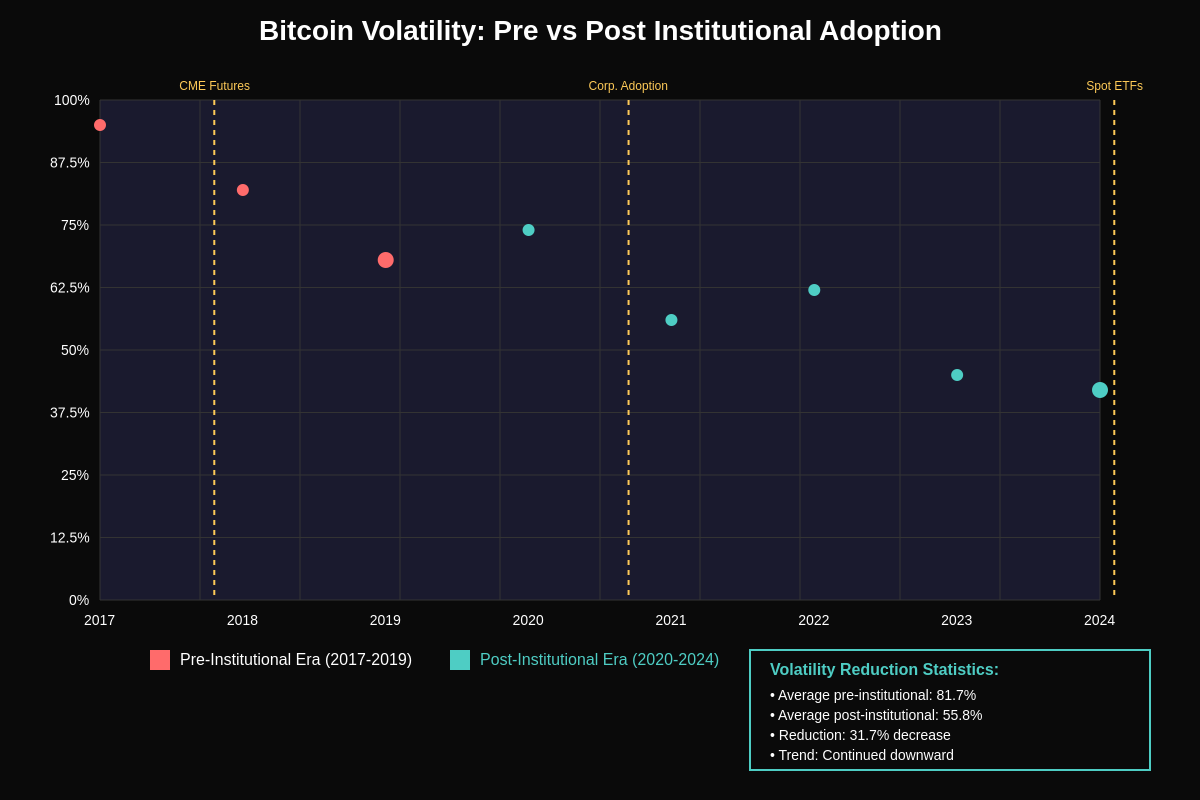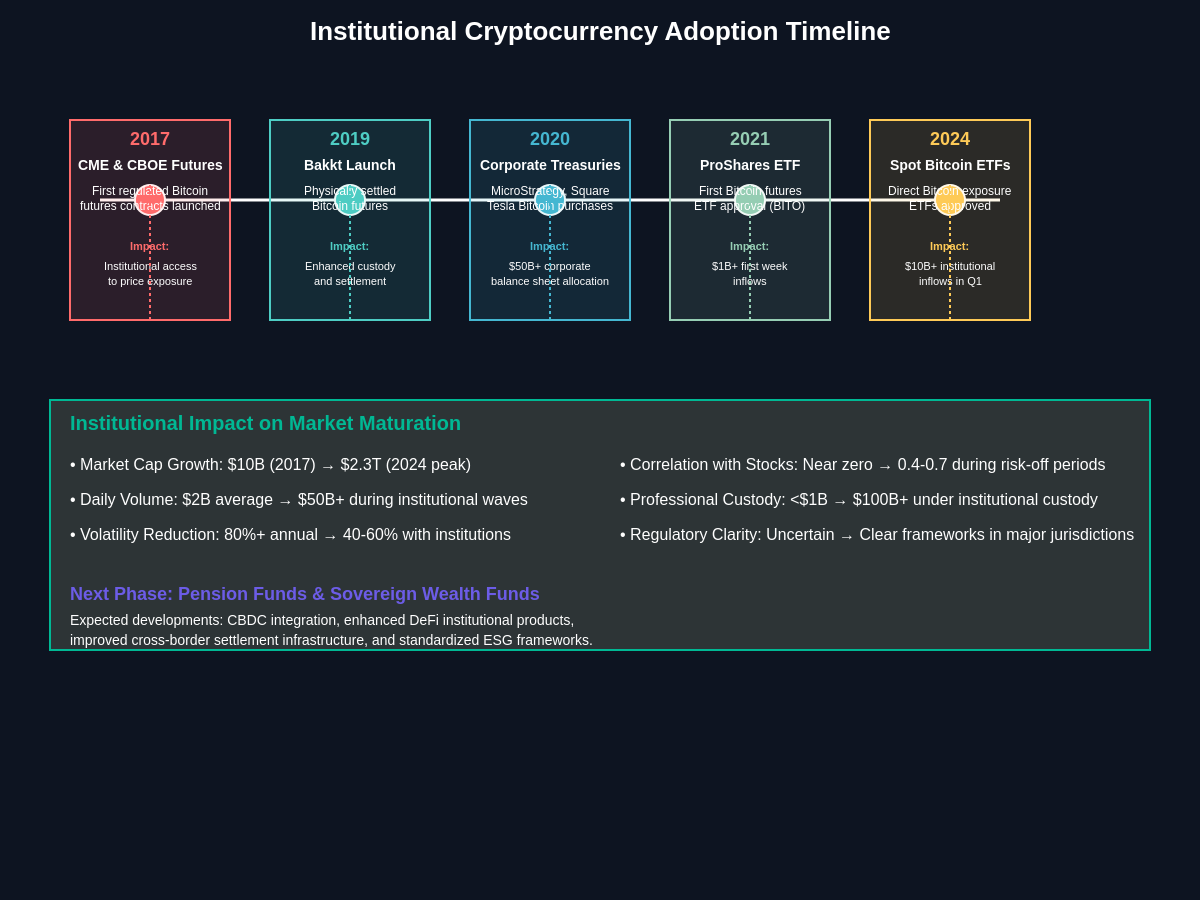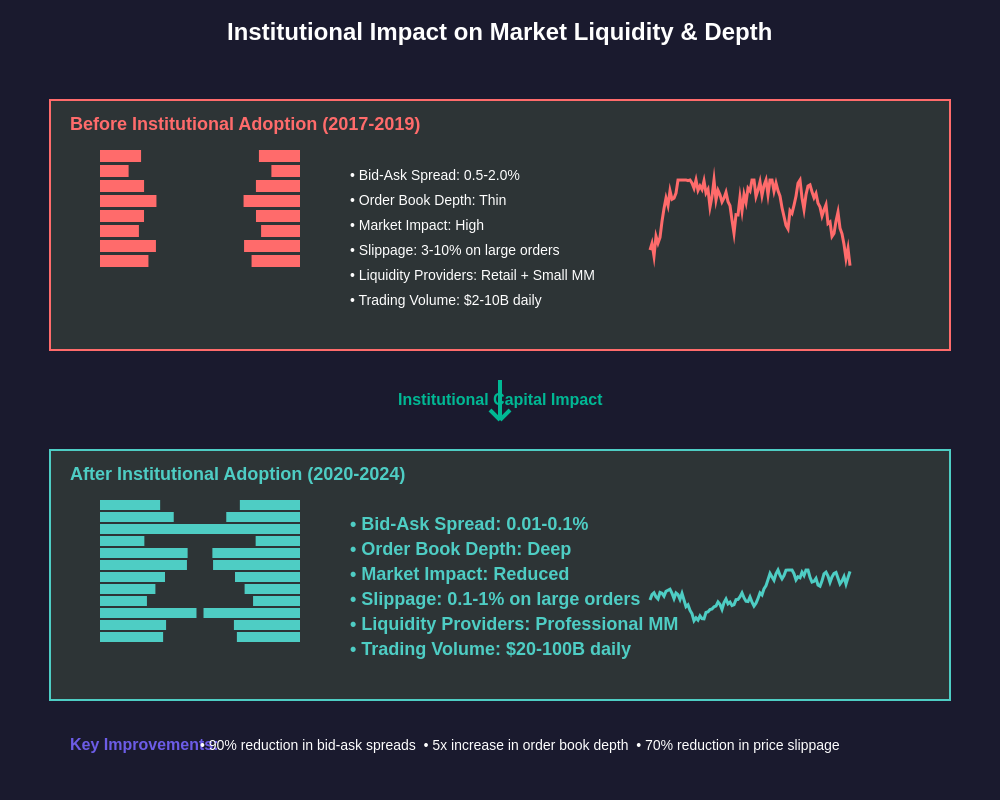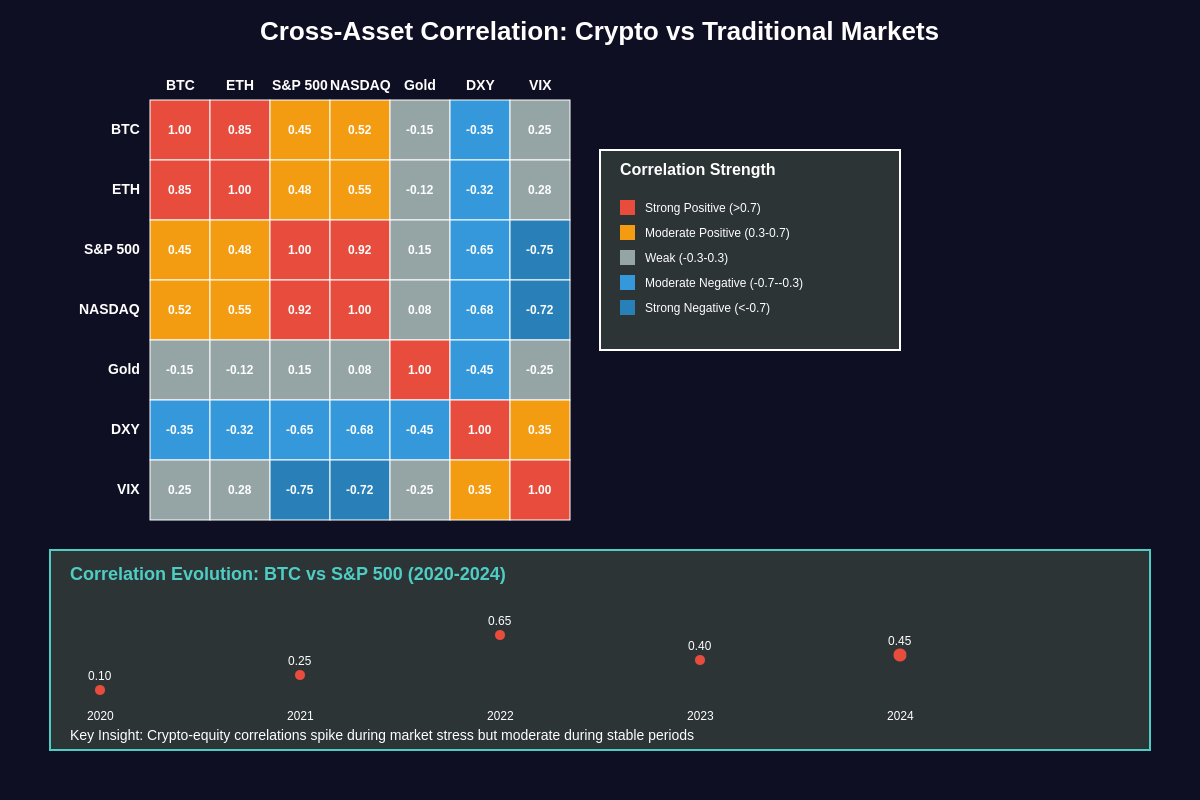Discover advanced trading strategies and technical analysis tools on TradingView to better understand market volatility patterns and institutional trading behaviors.
The Transformation of Market Dynamics Through Institutional Capital
The cryptocurrency market has undergone a fundamental transformation since major institutional players began allocating significant capital to digital assets, fundamentally altering the volatility characteristics that once defined this emerging asset class. Traditional financial institutions, including pension funds, insurance companies, hedge funds, and corporate treasuries, have collectively introduced unprecedented levels of capital sophistication and risk management practices that have measurably dampened the extreme price swings historically associated with cryptocurrency markets.

The entry of institutional capital has created a complex interplay between traditional financial market dynamics and the unique characteristics of decentralized digital assets, resulting in volatility patterns that increasingly resemble those found in mature financial markets while retaining certain unique features inherent to the cryptocurrency ecosystem. This institutional adoption has not eliminated volatility entirely but has instead transformed its nature, creating more predictable patterns while introducing new forms of correlation with traditional asset classes that previously exhibited minimal relationship with cryptocurrency prices.
The scale of institutional adoption has been remarkable, with corporate balance sheet allocations, ETF approvals, and institutional trading infrastructure development collectively bringing hundreds of billions of dollars in professional capital to markets that were previously dominated by retail speculation and early adopter enthusiasm. This capital influx has coincided with increasingly sophisticated trading algorithms, risk management systems, and hedging strategies that respond to market movements with far greater speed and precision than individual retail traders could achieve.
Historical Volatility Patterns Before Institutional Involvement
Before institutional adoption gained momentum around 2020, cryptocurrency markets exhibited volatility characteristics that were unprecedented in modern financial markets, with Bitcoin regularly experiencing daily price movements exceeding 10% and altcoins frequently seeing swings of 20% or more within single trading sessions. These extreme movements were driven primarily by retail sentiment, speculative trading, low liquidity, and the absence of sophisticated risk management practices that characterize institutional trading operations.
The cryptocurrency market’s volatility during its early years reflected the combination of technological uncertainty, regulatory ambiguity, limited adoption, and concentrated ownership among early adopters who often made emotional rather than systematic trading decisions. Historical cryptocurrency volatility data from this period shows patterns that would be considered extreme in any traditional asset class, with monthly volatility often exceeding 100% annualized and individual events capable of moving prices by 30% or more in either direction.
Market manipulation was also more prevalent during this period, with whale movements capable of single-handedly triggering massive price swings across entire market segments, and pump-and-dump schemes regularly affecting smaller cryptocurrencies with limited liquidity and market depth. The absence of institutional safeguards, sophisticated monitoring systems, and regulatory oversight created an environment where asymmetric information and coordinated manipulation could have outsized impacts on price discovery and volatility patterns.
Trading volumes during this period were characterized by extreme clustering around major news events, regulatory announcements, and technological developments, with periods of intense activity followed by extended periods of low volume and sideways price action. This resulted in volatility clustering that was far more pronounced than in traditional markets, with quiet periods suddenly interrupted by explosive price movements that could persist for days or weeks before returning to relative stability.
The Institutional Entry Wave and Market Maturation
The institutional entry into cryptocurrency markets began in earnest around 2017-2018 with the introduction of Bitcoin futures by major exchanges like CME and CBOE, but accelerated dramatically during 2020-2021 as corporations like Tesla, MicroStrategy, and Square announced significant Bitcoin acquisitions for their corporate treasuries. This wave of adoption represented far more than simple asset allocation decisions, introducing sophisticated trading infrastructure, regulatory compliance frameworks, and risk management practices that had been absent from cryptocurrency markets.

Institutional adoption brought with it the establishment of qualified custodial services, regulated trading platforms, and institutional-grade infrastructure that could handle the scale and security requirements demanded by professional asset managers and corporate treasurers. These developments created feedback loops that attracted additional institutional capital by addressing many of the operational and regulatory concerns that had previously prevented large-scale institutional participation in cryptocurrency markets.
The introduction of cryptocurrency exchange-traded funds, starting with Bitcoin futures ETFs and eventually progressing to spot Bitcoin ETFs, created new mechanisms for institutional exposure that avoided many of the technical and custody challenges associated with direct cryptocurrency ownership. These investment vehicles brought traditional portfolio management practices to cryptocurrency exposure, including systematic rebalancing, hedging strategies, and correlation-based risk management that had profound impacts on price volatility patterns.
Professional market makers and algorithmic trading firms also entered the space during this period, bringing sophisticated trading strategies that increased market efficiency while simultaneously reducing the impact of individual large orders on price volatility. These participants introduced liquidity provision strategies, arbitrage mechanisms, and cross-market hedging that created more stable price discovery processes across different trading venues and geographic regions.
Quantitative Analysis of Volatility Reduction Trends
Statistical analysis of cryptocurrency market volatility reveals clear trends toward reduced price volatility coinciding with increased institutional participation, with Bitcoin’s 30-day realized volatility declining from averages exceeding 80% annualized in 2017-2018 to averages closer to 40-60% during periods of high institutional activity in 2021-2024. These measurements represent substantial convergence toward volatility levels more consistent with growth stocks and emerging market currencies, though still elevated compared to developed market equities and bonds.
The distribution of daily returns has also shown marked changes, with the frequency of extreme outlier events (moves exceeding 5% daily) declining significantly while the clustering of returns around smaller daily movements has increased proportionally. Cryptocurrency volatility analysis tools demonstrate how institutional participation has created more normal distribution patterns in daily returns, reducing the fat-tail characteristics that previously made cryptocurrency returns difficult to model using traditional financial risk management frameworks.
Correlation analysis between institutional adoption metrics and volatility measures shows strong negative correlations, particularly during periods when major institutional announcements or investment flows coincide with periods of reduced market volatility. However, these relationships are not uniformly consistent, with certain types of institutional activity actually increasing short-term volatility while contributing to longer-term stability through improved market infrastructure and liquidity provision.
The term structure of implied volatility in cryptocurrency options markets has also evolved to reflect institutional participation, with volatility curves beginning to exhibit characteristics similar to those found in traditional asset classes, including volatility smiles, term structure effects, and sensitivity to macroeconomic events that extend beyond cryptocurrency-specific news and developments.
Liquidity Enhancement and Market Depth Improvements
Institutional participation has dramatically improved market liquidity and depth across major cryptocurrency trading venues, with order book thickness increasing substantially and bid-ask spreads narrowing to levels that approach those found in major currency and equity markets. These improvements have created more efficient price discovery mechanisms while reducing the market impact of individual large orders that previously could trigger cascading volatility events.

Professional market makers have introduced sophisticated algorithms that maintain continuous two-sided markets even during periods of market stress, providing liquidity when retail participants might otherwise retreat from trading activity. This consistent liquidity provision has reduced the volatility spikes that previously occurred during periods of market uncertainty when traditional participants would simultaneously attempt to exit positions.
The development of institutional-grade prime brokerage services has also enabled more sophisticated trading strategies including cross-venue arbitrage, delta hedging, and systematic market making that collectively contribute to more stable price relationships between different cryptocurrency trading platforms and derivative instruments. These activities have reduced the premium volatility that previously resulted from price disconnects between different trading venues and settlement mechanisms.
Institutional custody and settlement infrastructure has created more predictable trading flows by reducing the operational friction associated with large-scale cryptocurrency transactions, enabling institutional participants to execute complex multi-leg strategies and rebalancing activities without creating the dramatic price impacts that characterized earlier periods when such infrastructure was less developed.
Cross-Asset Correlation Effects and Portfolio Integration
The integration of cryptocurrency into institutional portfolios has introduced new correlation dynamics that have both stabilized cryptocurrency prices during certain market conditions while also introducing new sources of volatility related to traditional financial market movements. During periods of macroeconomic uncertainty, cryptocurrencies increasingly exhibit positive correlations with risk assets like growth stocks, reducing their effectiveness as portfolio diversifiers but also subjecting them to systematic risk factors that create more predictable volatility patterns.

Institutional risk management practices often require systematic portfolio rebalancing based on correlation relationships, creating predictable trading flows that can dampen volatility during normal market conditions while potentially amplifying movements during periods of extreme market stress when correlation relationships break down or strengthen unexpectedly. These dynamics have created new volatility regimes that are more closely tied to traditional financial market cycles than purely cryptocurrency-specific factors.
The increasing use of cryptocurrency as a hedge against currency debasement and inflation has introduced correlations with macroeconomic indicators including interest rates, inflation expectations, and currency movements that create new sources of fundamental price anchor points while potentially increasing sensitivity to central bank policy changes and macroeconomic data releases.
Cross-asset hedging strategies employed by institutional participants have also created complex volatility transmission mechanisms between cryptocurrency and traditional markets, with institutional participants using cryptocurrency positions to hedge other portfolio exposures or vice versa, creating interdependencies that can either stabilize or destabilize prices depending on the specific market conditions and hedging requirements of large institutional participants.
Regulatory Framework Evolution and Compliance Impact
The development of regulatory frameworks specifically designed to accommodate institutional cryptocurrency participation has created more predictable operating environments that have reduced regulatory uncertainty premiums previously embedded in cryptocurrency price volatility. Clear guidelines for custody, reporting, and fiduciary responsibility have enabled institutional participants to develop systematic approaches to cryptocurrency investment that reduce the ad-hoc decision making that contributed to volatility in earlier periods.
Regulatory clarity has also enabled the development of standardized risk management practices and compliance procedures that create more consistent institutional behavior during different market conditions, reducing the unpredictable responses to market events that characterized earlier periods when regulatory uncertainty created varied and sometimes conflicting institutional approaches to cryptocurrency exposure.
The establishment of regulatory oversight for cryptocurrency derivatives markets has introduced market surveillance and manipulation prevention measures that have reduced the impact of coordinated trading activities and artificial price movements that previously contributed to excessive volatility. These regulatory developments have created more confidence among institutional participants regarding market integrity and fair price discovery.
International regulatory coordination efforts have also reduced the volatility associated with conflicting regulatory approaches across different jurisdictions, creating more stable global trading environments and reducing the price dislocations that previously occurred when regulatory developments in major markets created uncertainty about continued institutional access to cryptocurrency markets.
Technology Infrastructure and Trading System Sophistication
The development of institutional-grade trading infrastructure has introduced sophisticated order management systems, algorithmic execution strategies, and risk management technologies that have fundamentally changed how large cryptocurrency transactions are executed and how their market impact is managed. Advanced order routing algorithms can now split large institutional orders across multiple venues and time periods, reducing the concentrated market impact that previously created volatility spikes around large institutional transactions.
High-frequency trading infrastructure adapted for cryptocurrency markets has introduced market making and liquidity provision strategies that maintain tighter bid-ask spreads and deeper order books, particularly during periods of high trading volume when retail participants might otherwise overwhelm available liquidity. These technological improvements have created more resilient market microstructure that can absorb larger order flows without generating proportional price movements.
Sophisticated risk management systems now monitor institutional cryptocurrency exposures in real-time, automatically adjusting positions and hedging requirements based on market conditions, portfolio correlations, and volatility forecasts that enable more systematic responses to market movements rather than the reactive trading behaviors that characterized earlier institutional approaches to cryptocurrency markets.
The integration of cryptocurrency trading systems with existing institutional portfolio management platforms has created more systematic rebalancing and risk management processes that generate more predictable trading flows while reducing the concentration of institutional trading activity around specific events or time periods that previously created volatility clustering effects.
Market Making and Algorithmic Trading Evolution
Professional market making in cryptocurrency markets has evolved from simple bid-ask spread capture to sophisticated multi-venue, cross-asset strategies that provide continuous liquidity while managing inventory risk through complex hedging mechanisms that span both cryptocurrency and traditional financial instruments. These advanced market making strategies have dramatically improved market depth and reduced the transaction costs associated with large institutional orders.
Algorithmic trading strategies specifically designed for cryptocurrency markets now incorporate machine learning algorithms, sentiment analysis, and cross-market arbitrage opportunities that create more efficient price discovery while simultaneously providing liquidity during periods when human traders might retreat from active participation. These algorithms often operate on timescales that are much faster than retail participant decision-making, creating stabilizing effects during short-term volatility events.
The development of prime brokerage relationships between traditional financial institutions and cryptocurrency market makers has created more sophisticated funding and hedging mechanisms that enable market makers to maintain positions and provide liquidity during periods of market stress when such services might otherwise become prohibitively expensive or unavailable.
Statistical arbitrage strategies that identify and exploit temporary price inefficiencies between different cryptocurrency assets or between cryptocurrency and traditional financial instruments have created more consistent price relationships while reducing the magnitude of price dislocations that previously contributed to volatility clustering around specific events or market conditions.
Corporate Treasury Adoption and Balance Sheet Strategies
The adoption of cryptocurrency as a corporate treasury asset has introduced new categories of institutional demand that operate on different timescales and with different risk management requirements than traditional investment management approaches, creating more stable long-term demand patterns while potentially reducing the frequency of large institutional redemptions during market downturns.
Corporate treasury strategies typically involve longer holding periods and less frequent rebalancing compared to active investment management approaches, creating a base level of institutional demand that is less sensitive to short-term market movements and technical trading signals that might otherwise trigger concentrated selling or buying pressure from more active institutional participants.
The integration of cryptocurrency holdings into corporate financial reporting and accounting frameworks has created more systematic approaches to position sizing, hedging requirements, and risk disclosure that reduce the likelihood of sudden corporate policy changes that might otherwise create unexpected institutional trading flows and associated volatility impacts.
Tax optimization strategies for corporate cryptocurrency holdings have also created more predictable patterns of institutional trading activity, with corporate participants increasingly using systematic approaches to realize gains and losses for tax purposes rather than making opportunistic trading decisions based on short-term market movements or technical analysis signals.
Pension Fund and Insurance Company Participation
The gradual adoption of cryptocurrency allocations by pension funds and insurance companies has introduced extremely large pools of capital that operate with very long investment horizons and sophisticated asset-liability matching requirements that create different volatility dynamics compared to more actively managed institutional capital or retail speculation.
These institutional participants typically implement cryptocurrency exposure through systematic allocation processes that are less sensitive to short-term price movements and more focused on long-term portfolio diversification and risk-adjusted return optimization, creating steady demand patterns that can provide price support during market downturns while avoiding the momentum-driven buying that might otherwise exacerbate price appreciation during bull markets.
The actuarial and risk management frameworks used by pension funds and insurance companies often require systematic hedging and rebalancing activities that create predictable institutional trading flows, but these activities are typically implemented gradually over extended periods rather than concentrated around specific market events or technical price levels.
Regulatory requirements for pension fund and insurance company cryptocurrency investments often include sophisticated risk monitoring and reporting requirements that create additional layers of systematic risk management and position sizing discipline that contribute to more stable institutional participation patterns compared to less regulated forms of institutional capital.
ETF Development and Passive Investment Flows
The development and approval of cryptocurrency exchange-traded funds has created new mechanisms for institutional and retail participation that introduce systematic buying and selling pressure based on fund flows rather than discretionary trading decisions, fundamentally changing the demand dynamics that influence cryptocurrency price volatility.
ETF creation and redemption mechanisms create arbitrage opportunities that help maintain more consistent price relationships between cryptocurrency prices and fund share prices, reducing the premium and discount volatility that might otherwise develop during periods of intense buying or selling pressure from fund investors.
Passive investment strategies implemented through cryptocurrency ETFs create more predictable institutional demand patterns that are based on systematic allocation models rather than active trading decisions, reducing the concentration of institutional trading activity around specific market events or technical price levels that might otherwise create volatility clustering effects.
The integration of cryptocurrency ETFs into broader portfolio management platforms has enabled institutional participants to maintain cryptocurrency exposure without directly managing the operational complexities of cryptocurrency custody and trading, creating more stable institutional participation that is less likely to be disrupted by operational challenges or regulatory uncertainties.
Risk Management Framework Standardization
The development of standardized risk management frameworks for institutional cryptocurrency investment has created more consistent institutional behavior during different market conditions, reducing the unpredictable institutional responses to market events that previously contributed to volatility amplification during periods of market stress.
Value-at-risk and stress testing methodologies specifically adapted for cryptocurrency markets now enable institutional participants to maintain systematic position sizing and hedging requirements that create more predictable institutional trading patterns while reducing the likelihood of forced liquidations during market downturns that might otherwise exacerbate volatility.
The establishment of industry best practices for cryptocurrency custody, operational risk management, and compliance procedures has reduced the operational risks that previously created unpredictable institutional behavior during periods of market stress or regulatory uncertainty, contributing to more stable institutional participation patterns.
Benchmark development and performance measurement standards for institutional cryptocurrency investment have created more systematic approaches to portfolio management and performance evaluation that reduce the discretionary decision-making that might otherwise create unpredictable institutional trading flows during different market conditions.
Future Implications and Emerging Trends
The continued evolution of institutional cryptocurrency adoption suggests ongoing convergence toward volatility characteristics that more closely resemble traditional financial markets, though certain unique features of cryptocurrency markets are likely to persist and continue influencing volatility patterns in ways that distinguish them from purely traditional asset classes.
Emerging trends including central bank digital currency development, regulatory harmonization across jurisdictions, and continued improvements in trading infrastructure suggest further potential reductions in cryptocurrency volatility, though the introduction of new categories of institutional participants and investment strategies may create new sources of volatility that are different from historical patterns.
The development of more sophisticated derivative instruments and hedging strategies specifically designed for cryptocurrency markets may enable institutional participants to manage risks more effectively while potentially creating new forms of volatility transmission between cryptocurrency and traditional financial markets that require ongoing monitoring and analysis.
Technological developments including improvements in blockchain scalability, transaction processing capabilities, and integration with traditional financial infrastructure may reduce certain sources of cryptocurrency-specific volatility while potentially introducing new forms of systematic risk that are tied to broader technological and regulatory developments in the financial services industry.
Disclaimer: This article is for informational purposes only and does not constitute financial advice. Cryptocurrency investments carry significant risks including the potential for total loss of capital. Market volatility can result in substantial gains or losses, and past performance does not guarantee future results. Institutional adoption trends and their impacts on market volatility are subject to change based on regulatory developments, market conditions, and technological factors. Always conduct thorough research and consider consulting with qualified financial professionals before making investment decisions. The analysis presented here is based on historical data and current market observations, which may not accurately predict future market behavior or institutional adoption patterns.